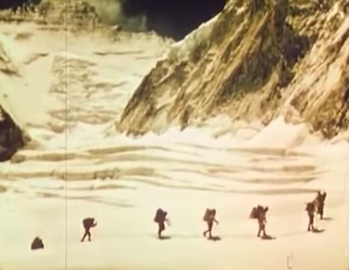2014, Август, 15
Эверест. Швейцарские экспедиции 1952 года
Эти экспедиции по-настоящему открыли маршрут восхождения на Эверест с юга. Некоторые ошибки и стечение обстоятельств не позволили завершить весеннюю экспедицию успехом. Впрочем, это воля небес и жаловаться швейцарцам не на что. Они сделали ...
Эти экспедиции по-настоящему открыли маршрут восхождения на Эверест с юга. Некоторые ошибки и стечение обстоятельств не позволили завершить весеннюю экспедицию успехом. Впрочем, это воля небес и жаловаться швейцарцам не на что. Они сделали большое дело и прославили свои имена.
Led by Edouard Wyss-Dunant, the 1952 Swiss Mount Everest expedition saw Raymond Lambert and Sherpa Tenzing Norgay reach a height of about 8,595 metres (28,199 ft) on the southeast ridge, setting a new climbing altitude record, opening up a new route to Mount Everest and paving the way for further successes by other expeditions..
Origins
Tibet had closed to foreigners but Nepal had just opened up. In 1951 Eric Shipton's British-New Zealand reconnaissance had climbed the Khumbu Icefall and reached the elusive Western Cwm, proving that Everest could be climbed from Nepal. Unfortunately for the British, who had enjoyed exclusive access to the mountain for 31 years, the Nepalese government gave the 1952 permit to the Swiss.
Organization
Edouard Wyss-Dunant was appointed leader of this expedition. All the expedition's participants were from Geneva, they almost all belonged to the exclusive L'Androsace climbing club and knew each other very well. The city and Canton of Geneva provided moral and financial support for the expedition, and the University of Geneva provided the scientific contingent.
In spite of having suffered amputation of frostbitten toes, Raymond Lambert was among the members of the expedition.
It is during this expedition that Tenzing Norgay was for the first time considered a full expedition member ("the greatest honour that had ever been paid me") forging a lasting friendship with the Swiss, in particular Raymond Lambert.
Goals
The mountaineering task that this team had set itself was primarily exploring the access to the South Col, the conquest of the labyrinthine Khumbu Icefall, and possibly the advance to the South Col. The team never even considered an attempt at an ascent of Everest.
Ascent
Building on Shipton's experience, the Genevans reached the head of the Western Cwm and climbed the huge face above to the desolate, wind-swept plateau of the South Col. Three Swiss climbers and Sherpa Tenzing Norgay continued towards the summit, pitching a tent at 8,400m. Two returned, leaving Tenzing and Lambert, who had become firm friends, to make a summit attempt. High altitude mountaineering in 1952 was still in its infancy. Even Swiss organisation and technology were not up to the job and, apart from Tenzing, the Sherpas had little experience. Despite the best plans, Tenzing and Lambert now had to spend a night at 8,400m with no sleeping bags and no stove, producing a trickle of drinking water by melting snow over a candle. The oxygen sets were barely operable and when the two men continued in the morning, they were effectively climbing without oxygen. They struggled heroically, at times crawling on all fours, hindered by the dead weight of malfunctioning oxygen sets, finally grinding to a halt near 8595m, approximately 250m short of the summit.
Assuming that George Mallory and Andrew Irvine did not reach higher in their 1924 expedition, this was the highest that anyone had ever been.
Results
Raymond Lambert and Tenzing Norgay were able to reach a height of about 8,595 metres (28,199 ft) on the southeast ridge, setting a new climbing altitude record. Tenzing's experience was useful when he was hired to be part of the British expedition in 1953 during which he summited with Edmund Hillary.
The results of this first Swiss Everest expedition are remarkable, and exceeded even the most optimistic expectations. At the first attempt, they had opened up a new route to Everest, and had reached an extraordinary height on the south-western ridge in difficult conditions. In the opinion of the extremely critical Marcel Kurz, this expedition could almost be compared to a victory. It paved the way for further successes by other expeditions.
The expedition named the Geneva Spur rock formation, between the Western Cwm and the South Col. During the 1956 Swiss Everest--Lhotse expedition, Geneva Spur was the location of the last high camp before Fritz Luchsinger and Ernst Reiss achieved the first ascent of Lhotse summit, on May 18, 1956.
Autumn expedition
There was a second Swiss expedition in the autumn of 1952, after the monsoon, the first serious attempt to climb Everest at that time of year. A party including Lambert, Tenzing and others made it to the South Col, but was forced back by extremely cold weather after reaching an altitude of 8,100 metres (26,575 ft)
